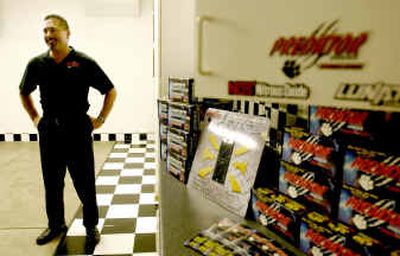Vroom to grow

POST FALLS — John Hatcher likes to show off how fast his Dodge accelerates.
His diesel truck glides from zero to 70 mph with an ease his friends envy. Even when he’s pulling an 18-foot trailer loaded down with electrical equipment, the Rathdrum contractor says he can zip up hills without losing power and accelerate quickly enough to merge smoothly onto the freeway.
“It’s just fast and fun,” said Hatcher, who credits the Dodge’s power to an electrical control module made by Predator Inc. of Post Falls. “Your big truck is able to keep up with the fast cars.”
Guys like Hatcher are Predator Inc.’s target audience. They drive workhorse diesels, but dream of a hot-rod engine under the hood.
Speed and acceleration are such serious pursuits that they’ll shell out hundreds of dollars to outfit a brand new, $40,000 pickup with an electronic control module. The chip overwrites the vehicle’s factory settings, increasing horsepower and torque by manipulating fuel and airflow to the engine.
“Horsepower is the speed of acceleration,” said Karl Lange, Predator’s vice president of sales and marketing. “Torque is the rip-you-out-of-your seat feeling.”
There’s a huge market for both, he said.
Electronic control modules represent one of the fastest-growing parts of the automotive accessory market, according to the Los Angeles-based Specialty Manufacturers Equipment Association.
Post Falls-based Predator Inc. got its foot in the door last year, with the release of the Predator Performance Module. It retails for about $550.
Predator’s module was developed by Barry Sadler, a local chiropractor who said he set aside medicine to tinker with diesel trucks.
In addition to Predator Inc., Sadler also owns Dr. Performance, a line of automotive accessories with a retail store in Texas, and Alternate Fuels Inc., a small research-and-development firm.
“I’ve used my foundation in chemistry and molecular science to understand fuel and how it burns,” he said.
Sadler said his electronic control module produces a cleaner fuel burn and better gas mileage. But that’s not necessarily foremost on his customers’ minds.
Predator’s target demographic is “white males, ages 20 to 75,” according to Lange. As the company name implies, the demographic tends toward testosterone-twinged stereotypes.
About 33 percent of the company’s customers are farmers who haul hay and chemicals in their 1-ton pickups. Another 40 percent are truck owners who tow trailers, RVs or boats.
“The rest would be the guy who just wants to go fast,” Lange said.
Predator Inc. is projecting sales of about $3.5 million this year. In 2005, the company hopes to double it sales by expanding its list of 60 wholesalers, Lange said.
The overall U.S. market for electronic control modules is about $500 million annually, he said.
Predator Inc. received national exposure this spring, when its control module was tested on a cable show called “Two Garage Guys.” The company paid about $30,000 to have the show review the product.
One of the viewers watching the show was Paul Clarry, manager of the automotive department at Spokane’s General Store. The test performance on “Two Garage Guys” helped persuade him to stock it.
“I try to really research the products we carry, but I don’t want 10 angry customers complaining about something they bought here,” Clarry said.
What impressed him about the Predator, he said, was that it doesn’t leave a “ghost code” on the engine that can be picked up by dealers’ diagnostic equipment. Some of the competition’s products do, he said. Though a “ghost code” shouldn’t affect warranties, customers often worry that it might, Clarry said.
Twice this summer, the General Store scheduled free Predator product demonstrations. People from as far away as Ellensburg rolled up in their 4-by-4s to try it out.
“It was like a rock concert, I kid you not,” Lange said.
Participants drove their vehicles onto ramps, where rollers around the wheels held the vehicles stationary. The drivers floored their gas pedals, accelerating from zero to 100 mph as fast as they could.
A portable dynamometer supplied by Predator Inc. measured each vehicle’s horsepower and torque with and without the Predator’s control module.
“It’s always crowd pleaser,” Lange said. Predator’s control modules are currently produced at a plant near Sadler’s retail store in Weatherford, Texas. Next year, Sadler said the manufacturing operation and its 25 jobs will move to either Kootenai County or Liberty Lake. Predator Inc. already owns land in Post Falls, but may need more room, he said.
The manufacturing plant was initially based in Texas because the state has such a “truck culture” and a high per-capita ownership of trucks, Lange said. But Sadler lives on a ranch in Mullan, Idaho, and Lange works out of a home office in Post Falls.
Both of them already spend lots of time on the road, promoting Predator Inc. at automotive trade shows.
“This is home for us,” Lange said.